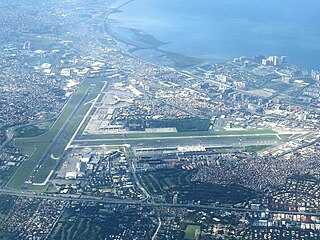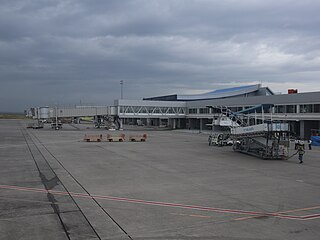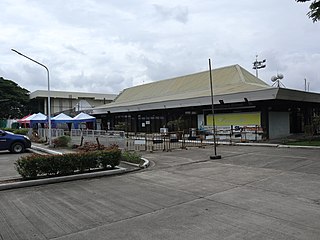
Ninoy Aquino International Airport, also known as Manila International Airport (MIA), is the main international airport serving Metro Manila in the Philippines. Located between the cities of Pasay and Parañaque, about 7 kilometers (4.3 mi) south of Manila proper and southwest of Makati, it is the main gateway for travelers to the Philippines and serves as a hub for PAL Express and Philippine Airlines. It is also the main operating base for AirSWIFT, Cebgo, Cebu Pacific, and Philippines AirAsia.

Legazpi Airport was a major airport in the Bicol Region, served the vicinity of Legazpi, the capital city of Albay in the Philippines.
Cebu Air, Inc., operating as Cebu Pacific, is a Philippine low-cost airline based at Pasay in Metro Manila. Founded in 1988, it is Asia's first low-cost airline and the Philippines' largest leading airline. It offers scheduled flights to both domestic and international destinations. The airline operates flights from five bases in Cebu, Clark, Davao, Iloilo, and its largest base in Manila.

Cebgo, Inc., operating as Cebgo, is the regional brand of Cebu Pacific. It is the successor company to SEAIR, Inc., which previously operated as South East Asian Airlines and Tigerair Philippines. It is now owned by JG Summit, the parent company of Cebu Pacific which operates the airline. The airline's main base has been transferred from Clark International Airport in Angeles City to Ninoy Aquino International Airport in Metro Manila. On April 30, 2017, Cebgo planned to move out from Manila and transfer its main base to Mactan–Cebu International Airport in Cebu City because NAIA has already maxed out its capacity. Currently, it operates an all-ATR fleet, with a total of 16 in service.

Zamboanga International Airport is the main airport serving Zamboanga City in the Philippines. Located on a 270-hectare (670-acre) site in Barangay Canelar, Zamboanga City, the airport is Mindanao's third-busiest airport after Francisco Bangoy International Airport in Davao City and Laguindingan Airport in Laguindingan, Misamis Oriental.

Dipolog Airport is the main airport serving the general area of Dipolog, the capital city of Zamboanga del Norte, in the Philippines. The airport is one of the busiest in Mindanao, especially considering its classification. It is classified as a Class 1 principal by the Civil Aviation Authority of the Philippines (CAAP), a body of the Department of Transportation (DOTr) responsible for the operations of airports in the Philippines except the major international ones.

Sibulan Airport, also known as Dumaguete Airport or Dumaguete–Sibulan Airport, is an airport serving the general area of the city of Dumaguete, located in the province of Negros Oriental in the Philippines. It is located 3 kilometers (1.9 mi) north of Dumaguete on a 63-hectare (160-acre) site in Barangay Agan-an in the nearby municipality of Sibulan. The airport is one of two major airports serving Negros Island, the other being Bacolod–Silay Airport in Silay, Negros Occidental.

Godofredo P. Ramos International Airport, also known as Caticlan International Airport and recently, Boracay Airport by its developer Trans Aire, is an international airport serving the general area of the municipality of Malay, located in the province of Aklan in the Philippines. It is one of the two gateways to Boracay, the other being Kalibo International Airport in Kalibo.

General Santos International Airport, also known as Tambler Airport and General Santos City Airport, is an alternate international airport located in the city of General Santos, Philippines serving the greater area of Soccsksargen. Situated in Fatima, General Santos, it is a large airport on the island of Mindanao and is officially classified as an international airport by the Civil Aviation Authority of the Philippines (CAAP), a government bureau which is responsible for the management and operations of General Santos International Airport and all other airports in the country except regular international airports.

Loakan Airport serves the general area of Baguio, Philippines. It is classified as a Class 2 principal airport by the Civil Aviation Authority of the Philippines (CAAP). Loakan Airport, the city's only airport, was built in 1934. Its short runway, frequent low visibility, and deep ravines at both ends of the runway continue to challenge pilots greatly, especially when it comes to landing.

Puerto Princesa International Airport is an airport serving the general area of Puerto Princesa, located in the province of Palawan in the Philippines. It is classified as an international airport by the Civil Aviation Authority of the Philippines.

Tuguegarao Airport is an airport serving the general area of Tuguegarao, the capital city of the province of Cagayan in the Philippines. Located along Maharlika Highway, the airport is accessible from adjacent municipalities in Cagayan and northern Isabela. It is classified as a major commercial domestic airport by the Air Transportation Office.

Kalibo International Airport is an international airport that serves the general area of Kalibo, the capital of the province of Aklan in the Philippines, and is one of two airports serving Boracay, the other being Godofredo P. Ramos Airport in the municipality of Malay. It is the fastest growing airport in the Philippines in terms of passenger traffic with more than 50% growth in 2010, and 2nd fastest for seats offered for June 2014 over the corresponding month of the previous year (20%). The airport is classified as an international airport by the Civil Aviation Authority of the Philippines, a body of the Department of Transportation responsible for the operations of all airports in the Philippines except major international airports.

Bancasi Airport, also known as Butuan Airport, is an airport serving the general area of Butuan and Agusan del Norte. It is the only airport in Agusan del Norte and the largest in Caraga. The airport is classified as an International Airport by the Civil Aviation Authority of the Philippines (CAAP), a body of the Department of Transportation (DOTr) that is responsible for the operations of not only this airport but of all the other airports in the Philippines, except the major international airports.

Sanga-Sanga Airport, also known as Tawi-Tawi Airport, is an airport serving the general area of Bongao, the capital of the province of Tawi-Tawi in the Philippines. The airport is classified as a Class 2 principal airport by the Civil Aviation Authority of the Philippines. It is not an international airport, contrary to its classification by the Tawi-Tawi provincial government. It is located in Sanga-Sanga Island. The airport was formerly referred by the IATA with the code SGS until the end of 2011, when its IATA code was finally changed to TWT.

Sayak Airport, commonly known as Siargao Airport, is the main airport serving Siargao Island located in Del Carmen, Surigao del Norte, Philippines. The airport is designated as a Class 2 principal airport by the Civil Aviation Authority of the Philippines (CAAP).
Air Philippines Corporation, operating as PAL Express and formerly branded as Air Philippines and Airphil Express, is a wholly-owned subsidiary airline of Philippine Airlines. It is PAL's regional brand, with services from its hubs in Manila, Clark, Cebu, and Davao.
Magnum Air (SkyJet), Inc., operating as SkyJet Airlines, is a Philippine low-cost regional airline based in Manila, Philippines. Previously an air charter company, SkyJet commenced commercial operations on 14 December 2012, offering direct flights from Manila to underserved destinations, particularly, Basco, Batanes; Coron, Palawan; San Vicente, Palawan; and Camiguin. It bills itself as the first boutique airline in the Philippines.

Mactan–Cebu International Airport (MCIA) is an international airport serving Cebu and serves as the main gateway to the Central Visayas region in the Philippines. Located on a 797-hectare (1,970-acre) site in Lapu-Lapu City on Mactan, it is the second busiest airport in the Philippines. Opened on April 27, 1966, the airport serves as a hub for Philippine Airlines, and as an operating base for Cebu Pacific, Philippines AirAsia, and Sunlight Air.






















